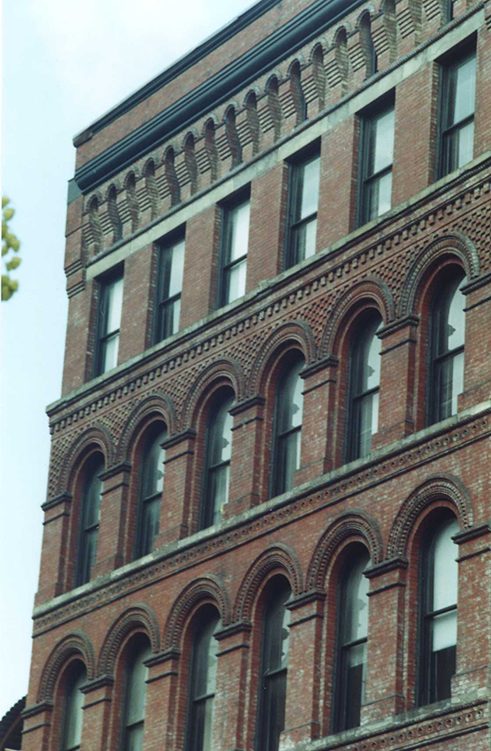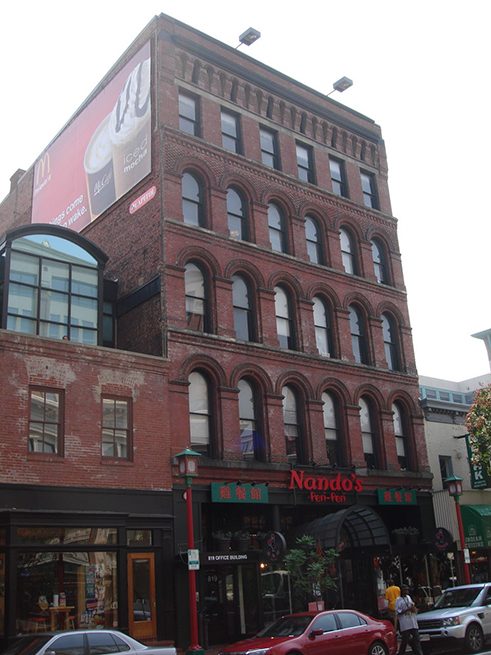819-821 Seventh St. NW
German Roots in DC
-
819-821 Seventh Street NW, 2010. -
Constructed in 1891 to house an Irish-American business, Grogan’s Furniture Store, the building has been restored and is fully occupied. Faded signs for Grogan’s are still visible on the north and south walls of the building.
Julius Germuiller, Architekt
Architect Julius Germuiller (originally Germüller) was born in Washington, D.C., March 18, 1859 and died here January 10, 1929. At the time of his death, he was a resident of the Little Sisters of the Poor Home on H Street NE. His father, Francis Germuiller, who operated a saddlery and harness business at 741 7th Street NW, immigrated to Washington from Bavaria in 1850. The Germuiller family is interred at St. Mary's Catholic Cemetery, Washington, DC.
It is believed that Julius Germuiller received some of his early education at St. Mary's Catholic School; however, that fact has not yet been confirmed. Germuiller was first listed as an architect in the Washington City Directory of 1879, when he would have been only twenty years of age. He continued to practice his profession until the mid 1920's. His various offices, located at 513 7th Street NW, 615 E Street NW, 456 Louisiana Avenue NW and 402 6th Street NW, have all been demolished.
Germuiller's practice was largely confined to residential structures. Between 1879 and 1923, he designed over 300 houses which were built in every quadrant of Washington city and also in Georgetown, Mount Pleasant, Bloomingdale and Brightwood Park, both for individual owners and for speculators. Chief among the latter were builder Diller B. Groff and real estate man A. Behrends. Among his individual clients were John Sherman, Gen. A. D. Hazen, Philip Larner and William Holmead.
Most of the Germuiller-designed structures in the near northwest, in Swampoodle and in the Northern Liberties have been demolished as have the buildings in southwest. The largest group of Germuiller buildings extant is on Capitol Hill, primarily in the near northeast. A few remain also in Georgetown and near Dupont, Logan and Washington Circles. Many of the Brightwood Park and Bloomingdale houses are also extant. However, a small church which he designed in Brightwood Park was demolished about 1950. A very few small commercial buildings are still to be found along D Street NW and H Street NE. A small department store at the southeast corner of 8th and I Streets SE also remains as does a small apartment house at 462 K Street NW. The home which Germuiller designed for his father at 611 I Street NW and his own home at 122 Florida Avenue NW both have been demolished.
Julius Germuiller's buildings are distinguished by the use of ornamental details executed in moulded brick and carved stone. He often used slate roofs. Germuiller-designed buildings were usually brick, although a number were constructed of a combination of stone and brick. The façade of one house on N Street in Georgetown is built entirely of stone. Several houses in Brightwood Park were frame. An unusual feature of some of his semidetached houses in Brightwood Park is the use of the hipped roof, a roof style seldom seen in Washington architecture after the Civil War. Germuiller had considerable success in designing buildings for unusually shaped corner lots, using to bests advantage the corner tower, sometimes round and sometime octagonal. He was one of the first architects to use the oriel on Washington row houses.
Most of the speculative houses Germuiller designed for Diller Groff were modest two- or three-story bayfronted row houses. Even these have better than average architectural details. Probably the finest row of extant houses done for Groff is located on the south side of the 600 block of Maryland Avenue NE.
By Hazel P. Kreinheder
May 15, 1979

